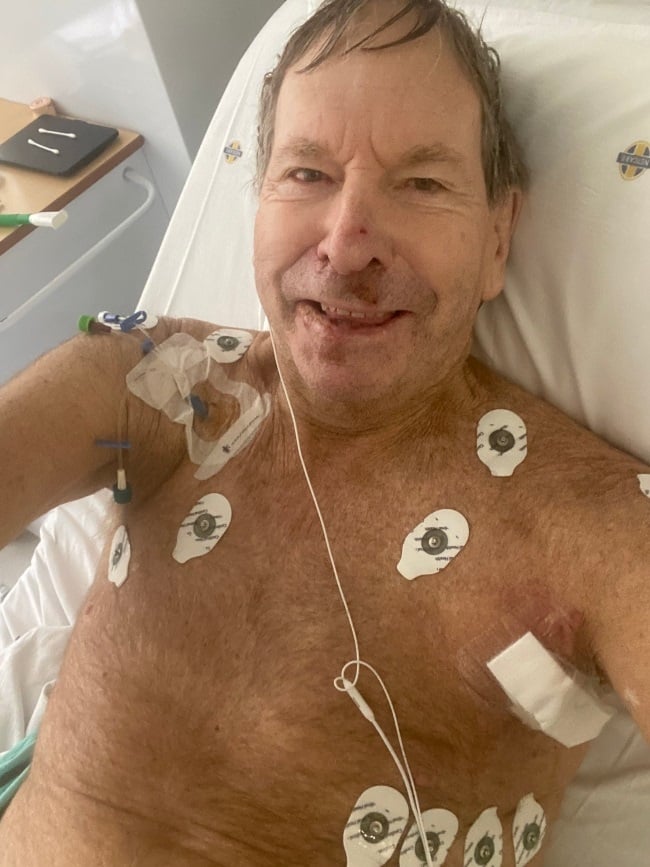
Television stalwart and veteran journalist Derek Watts has died after a year-long battle with cancer.
Just two months ago he was said to be “strong and cheerful” despite his ongoing battle. But Derek's friend and former co-worker, Ruda Landman, confirmed his death on Tuesday morning.
This story was first published on 23 June 2023.
He’s a staple of Sunday night television, a respected investigative journalist whose face has been beamed into many of our living rooms every week for the past 35 years.
So why, many viewers wondered, has Derek Watts been missing from our screens for a few weeks?
By now many know the answer: the Carte Blanche presenter has taken time out to focus on his health after doctors told him the skin cancer he was diagnosed with last year has now spread to his lungs.
READ MORE | Lord of the Dance star Michael Flatley is fighting aggressive cancer
Derek had continued to present the investigative news show after his initial diagnosis last year, but in March things took a turn for the worse.
He collapsed while with his family in Hoedspruit, Limpopo, and had to be airlifted to Milpark Hospital in Johannesburg, where he was diagnosed with a severe case of sepsis.
Derek initially thought he’d had a stroke or heart attack and in a taped recording from his hospital bed, he assured viewers he’d be back on the small screen in no time.
But three months later he was back in hospital – and this time no promises have been made.
The veteran journalist is now recovering at home with the help of his wife, Belinda, and isn’t granting interviews.
His friend and former co-worker, Ruda Landman, says having a positive outlook is helping him in his attempt to fight the cancer ravaging his body.
Ruda (69) recently visited him in hospital and even though he’s lost some weight, he looks strong and cheerful. “He hasn’t lost that eternal optimism for which he’s so famous,” she tells YOU.
“He’s especially grateful for all the messages of support and prayers he receives from the viewers. That moral support makes him strong and gives him hope.”
Derek and Ruda became a power pair on the small screen when they started working for Carte Blanche in 1988. The show was new to M-Net and the two had to learn to work together.
Derek was a TV sports presenter at the time and Ruda a presenter of an Afrikaans TV actuality programme.
“Although we didn’t know each other at all, we quickly found each other’s rhythm and worked very comfortably with each other as colleagues and as presenters,” she recalls.
The Carte Blanche team came together on Tuesdays and worked through all the newspapers to identify stories for the show.
“What immediately struck me was Derek’s strong news instinct,” Ruda says. “He’s a news person through and through – he knew immediately which story would work and which wouldn’t.”
Derek has made a name for himself as a journalist relentlessly hunting down a story and holding people accountable. But he’s shown he also has a great sense of humour.
He caused a stir on social media when he featured in a Castle Lite advert last year and broke out some dance moves to prove he can lighten up.
“While it’s not Strictly Come Dancing, I got to do a few moves and had a ton of fun while I was at it,” he said at the time.
He’s never taken himself too seriously, Ruda says. She laughs as she recalls an incident that happened when they were covering M-Net’s annual charity programme, Red Nose Day.
“We’re busy in a public place and Derek gets hold of this bra somewhere. He puts it on and the cameras flash with him in the bra and a G-string around his neck!”
After she left the show in 2007, they continued to keep in touch. Every year in November, the month in which they both celebrate their birthdays, they get together to catch up and gossip.
Even so many years after she left Carte Blanche, people still stop Ruda to ask how things are going. “In the same sentence they ask ‘But how is Derek?’,” she says.
She’s rooting for her friend to recover and knows he has the best medical care available to help on his journey to recovery.
Derek hasn’t lost the charm he’s become known for – he recently thanked fans on social media and shared his optimism.
“Really just wanted to say to our viewers. Thank you for all the love, the messages, the prayers that give us all hope.
“And thanks, of course, for continuing to watch Carte Blanche. I’ll be back soon. Have a magic week and cheers for now.”
Types of skin cancer
There are many types of skin cancer and it’s unclear what type Carte Blanche stalwart Derek Watts has.
According to the South African National Cancer Registry, more than 22 000 South Africans were diagnosed with the most common skin cancers – basal cell carcinoma and squamous cell carcinoma – in 2019. And more than 2 100 were diagnosed with the most dangerous, melanoma, according to the organisation.
Basal cell carcinoma This is considered the most common type of skin cancer. It usually affects people who have lighter skin, although darker-skinned people can also get it.
It typically develops after many years of frequent exposure to the sun and appears as a flesh-coloured round mass, a pearl-like bump or a patch of skin that has turned pink.
It often develops on the head, neck and arms, but isn’t limited to those areas. If not diagnosed and treated early, it can penetrate the nerves and bones.
Squamous cell carcinoma This occurs when squamous cells, found near the surface of the skin that shed and reform, undergo abnormal changes due to UV radiation from the sun.
They are identified as scaly red patches; open sores; rough, thickened or wart-like skin; or growths that are a bit hollow in the centre.
They usually appear in areas that are mostly exposed to the sun, including lips and ears, but they can also form on genitals.
This type of cancer can be easily treated but if left to grow, it can spread to other parts of the body and be fatal.
Melanoma This is the most dangerous type because it grows quickly and can spread to any organ. It develops from skin cells that produce melanin and can appear either brown in colour, pink, red or purple.
A minority of melanomas begin in existing moles and the rest start on normal mole-free skin. Derma¬tologists recommend people who have many moles keep track of them – this can be done with a process known as mole-mapping, using sophisticated equipment that can detect if the shape of the mole is changing in a dangerous way.
Melanoma is very invasive and aggressive, but can be treated and cured if caught in its early stages.
SOURCES: NEWS24.COM, DSTV.COM, CITIZEN.CO.ZA, SKINCANCER.ORG, AAD.ORG, MY.CLEVELANDCLINIC.ORG, CANSA.ORG.ZA




 Publications
Publications
 Partners
Partners



















